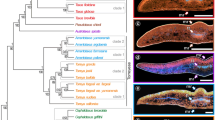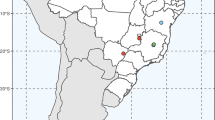Abstract
Bulbophyllum section Micranthae comprises 12 species of rupicolous or epiphytic orchids occurring in forests or in open rocky fields in Cerrado/Atlantic Forest ecotones throughout South America. We examined the leaf anatomy of 14 species and compared them with molecular data (nrITS) in phylogenetic analyses. The leaves of Bulbophyllum section Micranthae are characterised by uniseriate epidermis, with periclinal external cell wall thicker than the internal, presence of epicuticular wax, stomata present only on the abaxial surface with suprastomatic chambers, and collateral vascular bundles associated with sclerenchyma fibres. Some of these characters are shared with other rupicolous Orchidaceae species, demonstrating adaptive convergence in xeromorphic habitats. We found some anatomical characteristics with phylogenetic value. Bulbophyllum section Micranthae can be separated into two lineages: those with needle-like leaves, or flat leaves. The analyses show that anatomical characters as well as molecular data may contribute to the development of phylogenetic hypotheses.


Similar content being viewed by others
References
APG III (2009) An update of the Angiosperm Phylogeny Group classification for the orders and families of flowering plants: APG III. Bot J Linn Soc 161:105–121
Barros F, Vinhos F, Rodrigues VT, Barberena FFVA, Fraga CN (2012) Orchidaceae in Lista de Espécies da Flora do Brasil. Jardim Botânico do Rio de Janeiro. (http://floradobrasil.jbrj.gov.br/2012/FB000179). Accessed 5 Feb 2012
Bremer K (1988) The limits of amino acid sequence data in angiosperm phylogenetic reconstructions. Evolution 42:795–803
Carlsward BS, Stern WL, Judd WS, Lucansky TW (1997) Comparative leaf anatomy and systematics in Dendrobium, sections Aporum and Rhizobium (Orchidaceae). Int J Plant Sci 158:332–342
Colless DH (1980) Congruence between morphometric and alloezime data for Menidia species: a reappraisal. Syst Zool 29:288–299
Colless DH (1981) Predictivity and stability in classifications: some comments on recent studies. Syst Zool 30:325–331
De Pinna MGG (1991) Concepts and tests of homology in the cladistic paradigm. Cladistics 7:367–394
Dressler RL (1981) The orchids: natural history and classification. Harvard University Press, Cambridge
Dressler RL (1993) Phylogeny and classification of the orchid family. Dioscorides Press, Cambridge
Feder N, O’Brian TP (1968) Plant microtechnique: some principles and new methods. Am J Bot 55:123–142
Felsenstein J (1985) Confidence limits on phylogenies: an approach to using bootstrap. Evolution 39:783–791
Figueroa C, Salazar GA, Zavaleta HÁ, Engleman EM (2008) Root character evolution and systematics in Cranichidinae, Prescottiinae and Spiranthinae (Orchidaceae, Cranichideae). Ann Bot 101:509–520
Fischer GA, Gravendeel B, Sieder A, Adriantiana J, Heiselmayer P, Cribb PJ, Smidt EC, Samuel R, Kiehn M (2007) Evolution in resupination of Malagasy species of Bulbophyllum (Orchidaceae). Mol Phylogenet Evol 46:358–376
Fitch WM (1971) Towards defining the course of evolution: minimum change for a specific tree topology. Syst Zool 20:406–416
Freudenstein JV, Rasmussen FN (1999) What does morphology tell us about orchid relationships? A cladistic analysis. Am J Bot 86:225–248
Garcia-Cruz J, Sosa V (2006) Coding quantitative character data for phylogenetic analysis: a comparison of five methods. Syst Bot 31:302–309
Hendy MD, Penny D (1982) Branch and bound algorithms to determine minimal evolutionary trees. Math Biosci 60:133–142
Johansen DA (1940) Plant microtechnique. McGraw Hill, New York
Koehler S, Williams NH, Whitten WM, Amaral ME (2002) Phylogeny of the Bifrenaria (Orchidaceae) complex based on morphology and sequence data from nuclear rDNA internal transcribed spacers (ITS) and chloroplast trnL-F region. Int J Plant Sci 163:1055–1066
Mohana-Rao PR, Khasim SM (1987) Anatomy of three species of Bulbophyllum (Orchidaceae) with comments on their ecological adaptability and taxonomy. Proc Indian Acad Sci Plant Sci 97:391–397
Müller K (2004) PRAP—calculation of Bremer support for large data sets. Mol Phylogenet Evol 31:780–782
Page RDM (2001) Nexus Data Editor. http://taxonomy.zoology.gla.ac.uk/rod/NDE.html. Accessed 10 Jan 2012
Pridgeon AM (1982) Diagnostic anatomical characters in the Pleurothallidinae (Orchidaceae). Am J Bot 69:921–938
Pridgeon AM (1994) Systematic leaf anatomy of Caladeniinae (Orchidaceae). Bot J Linn Soc 114:31–48
Pridgeon AM, Cribb PJ, Chase MW, Rasmussen FN (2005) Genera Orchidacearum, vol. 4) Epidendroideae part 1). Oxford University Press, Oxford
Roeser KR (1962) Die Nadel der Schwarzkiefer Massenprodukt und Kunstwerk der Natur. Mikrokosmos 61:33–36
Scatena VL, Nunes AC (1996) Anatomia de Pleurothallis rupestris Lindl. (Orchidaceae) dos campos rupestres do Brasil. Bol Bot (USP) 15:35–43
Scatena VL, Giulietti AM, Borba EL, van den Berg C (2005) Anatomy of Brazilian Eriocaulaceae: correlation with taxonomy and habitat using multivariate analyses. Plant Syst Evol 253:1–22
Sereno PC (2007) Logical basis for morphological characters in phylogenetics. Cladistics 23:565–587
Sieder A, Rainer H, Kiehn M (2007) CITES checklist for Bulbophyllum and allied taxa (Orchidaceae). Botanical Garden, University of Vienna. http://www.cites.org/common/com/NC/tax_ref/Bulbophyllum.pdf. Accessed 5 Feb 2012
Smidt EC, Borba EL (2007) Bulbophyllums in Brazil: collection history and distribution. Orchids 76:130–133
Smidt EC, Silva-Pereira V, Borba EL, van den Berg C (2007) Richness, distribution and important areas to preserve Bulbophyllum in the neotropics. Lankesteriana 7:107–113
Smidt EC, Borba EL, Gravendeel B, Fischer GA, van den Berg C (2011) Molecular phylogeny of the neotropical sections of Bulbophyllum (Orchidaceae) using nuclear and plastid spacers. Taxon 60:1050–1064
Stearn WT (2004) Botanical Latin, 4th edn. Timber Press, Portland
Stern WL, Judd WS (2001) Comparative anatomy and systematics of Catasetinae (Orchidaceae). Bot J Linn Soc 136:153–178
Stern WL, Morris MW, Judd WS (1994) Anatomy of the thick leaves in Dendrobium section Rhizobium (Orchidaceae). Int J Plant Sci 155:716–729
Swofford DL (2003) PAUP*. Phylogenetic analysis using parsimony (*and other methods). Version 4). Sinauer Associates, Sunderland
Thiele K (1991) The holy grail of the perfect character: the cladistic treatment of morphometric data. Cladistics 9:275–304
Vermeulen JJ (1991) Orchids of Borneo, v.2) Bulbophyllum. Royal Botanic Gardens, Kew
Wiens JJ (2001) Character analysis in morphological phylogenetics: problems and solutions. Syst Biol 50:689–699
Williams NH (1979) Subsidiary cells in the Orchidaceae: their general distribution with special reference to development in the Oncidieae. Bot J Linn Soc 78:41–66
Wortley AH, Scotland RW (2006) The effect of combining molecular and morphological data in published phylogenetic analyses. Syst Biol 55:677–685
Acknowledgments
The authors would like to thank the Conselho Nacional de Desenvolvimento Científico e Tecnológico (CNPq 301692/2010-6; PIBIC/UNESP/CNPq) for financial support.
Author information
Authors and Affiliations
Corresponding author
Rights and permissions
About this article
Cite this article
Smidt, E.C., Gallo, L.W. & Scatena, V.L. Leaf anatomical and molecular studies in Bulbophyllum section Micranthae (Orchidaceae) and their implications for systematics. Braz. J. Bot 36, 75–82 (2013). https://doi.org/10.1007/s40415-013-0008-3
Received:
Accepted:
Published:
Issue Date:
DOI: https://doi.org/10.1007/s40415-013-0008-3




